Wampanoag
The Wampanoag /ˈwɑːmpənɔːɡ/, also rendered Wôpanâak, are a Native American people. They were a loose confederation of several tribes in the 17th century, but today Wampanoag people encompass five officially recognized tribes. The Mashpee Wampanoag Tribe and the Wampanoag Tribe of Gay Head in Massachusetts are federally recognized, and the Herring Pond , Assawompsett-Nemasket Band of Wampanoags, and Pocasset Wampanoag Tribe (Pokonoket) are recognized by the Commonwealth of Massachusetts.[1] They lived in southeastern Massachusetts and Rhode Island in the beginning of the 17th century, at the time of first contact with the English colonists, a territory that included the islands of Martha's Vineyard and Nantucket. Their population numbered in the thousands; 3,000 Wampanoag lived on Martha's Vineyard alone.
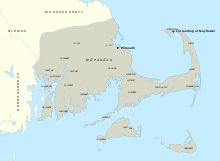 Map of Wampanoag territory circa 1620 | |
| Total population | |
|---|---|
| 2000+ | |
| Regions with significant populations | |
| Bristol County, Massachusetts, Dukes County, Massachusetts, Barnstable County, Massachusetts, Mashpee, Massachusetts, and Nantucket, Massachusetts | |
| Languages | |
| English, historically Wôpanâak | |
| Religion | |
| Wampanoag spirituality, Christianity | |
| Related ethnic groups | |
| other Algonquian peoples |
From 1615 to 1619, the Wampanoag suffered an epidemic, long suspected to be smallpox. Modern research, however, has suggested that it may have been leptospirosis, a bacterial infection which can develop into Weil's syndrome. It caused a high fatality rate and decimated the Wampanoag population. Researchers suggest that the losses from the epidemic were so large that colonists were able to establish their settlements in the Massachusetts Bay Colony more easily.[2] More than 50 years later, King Philip's War (1675–1676) of the Narragansett and their allies against the colonists and their Native American allies resulted in the death of 40 percent of the surviving tribe. Many male Wampanoag were sold into slavery in Bermuda or the West Indies, and some women and children were enslaved by colonists in New England.
The tribe largely disappeared from historical records after the late 18th century, although its people and descendants persisted. Survivors continued to live in their traditional areas and maintained many aspects of their culture, while absorbing other peoples by marriage and adapting to changing economic and cultural needs in the larger society. The last speakers of the Massachusett language Wôpanâak died more than 100 years ago, although some Wampanoag people have been working on a language revival project since 1993.
Name
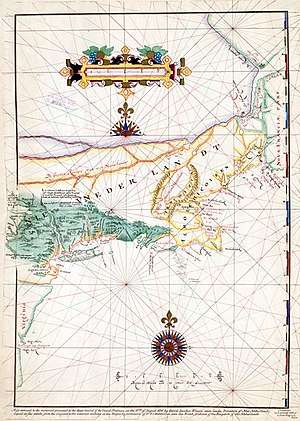
Wampanoag is probably derived from Wapanoos, first documented on Adriaen Block's 1614 map, which was the earliest European representation of Wampanoag territory. The word is a Delaware term for "Easterners" or literally "People of the Dawn",[3] and based on information provided by the people whom Block encountered in the lower Hudson Valley.[4]
In 1616, John Smith correctly referred to the tribe in the area as the Pokanoket. Pokanoket was used in the earliest colonial records and reports. The Pokanoket tribal seat of Sowams was located near Warren, Rhode Island.
Wampanoag groups and locations
| Group | Area inhabited |
|---|---|
| Gay Head or Aquinnah | western point of Martha's Vineyard |
| Chappaquiddick | Chappaquiddick Island |
| Nantucket | Nantucket Island |
| Nauset | Cape Cod |
| Mashpee | Cape Cod |
| Patuxet | eastern Massachusetts, on Plymouth Bay |
| Pokanoket | eastern Massachusetts and East Bay Rhode Island including Warren, Rhode Island |
| Pocasset | north Fall River, Massachusetts |
| Herring Pond | Plymouth & Cape Cod |
| Assonet | Freetown |
Culture
The Wampanoag people were semi-sedentary, with seasonal movements between sites in southern New England.[5] The men often traveled far north and south along the Eastern seaboard for seasonal fishing expeditions, and sometimes stayed in those distant locations for weeks and months at a time. The women cultivated varieties of the "three sisters" (maize, climbing beans, and squash) as the staples of their diet, supplemented by fish and game caught by the men.[5] Each community had authority over a well-defined territory from which the people derived their livelihood through a seasonal round of fishing, planting, harvesting, and hunting. Southern New England was populated by various tribes, so hunting grounds had strictly defined boundaries.
The Wampanoag had a matrilineal system, like many indigenous peoples of the Northeastern Woodlands, in which women controlled property, and hereditary status was passed through the maternal line. They were also matrifocal; when a young couple married, they lived with the woman's family. Women elders could approve selection of chiefs or sachems. Men acted in most of the political roles for relations with other bands and tribes, as well as warfare. Women passed plots of land to their female descendants, regardless of their marital status.[6]
The production of food among the Wampanoag was similar to that of many American Indian societies, and food habits were divided along gender lines. Men and women had specific tasks. Women played an active role in many of the stages of food production, so they had important socio-political, economic, and spiritual roles in their communities.[7] Wampanoag men were mainly responsible for hunting and fishing, while women took care of farming and gathering wild fruits, nuts, berries, and shellfish.[8] Women were responsible for up to 75 percent of all food production in Wampanoag societies.[9][5]
The Wampanoag were organized into a confederation where a head sachem presided over a number of other sachems. The colonists often referred to him as "king", but the position of a sachem differed in many ways from a king. They were selected by women elders and were bound to consult their own councilors within their tribe, as well as any of the "petty sachems" in the region.[10] They were also responsible for arranging trade privileges, as well as protecting their allies in exchange for material tribute.[11] Both women and men could hold the position of sachem, and women were sometimes chosen over close male relatives.[12]
Pre-marital sexual experimentation was accepted, although the Wampanoag expected fidelity within unions after marriage. Roger Williams (1603–1683) stated that "single fornication they count no sin, but after Marriage... they count it heinous for either of them to be false."[13] Polygamy was practiced among the Wampanoag, although monogamy was the norm. Some elite men could take several wives for political or social reasons, and multiple wives were a symbol of wealth because women were the producers and distributors of corn and other food products. Marriage and conjugal unions were not as important as ties of clan and kinship.
Language revival
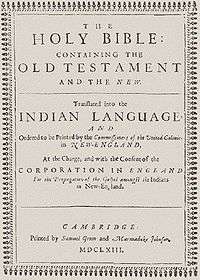
The Wampanoag originally spoke Wôpanâak, a dialect of the Massachusett language which belongs to the Algonquian languages family. The first Bible published in America was a 1663 translation into Wampanoag by missionary John Eliot. He created an orthography which he taught to the Wampanoag. Many became literate, using Wampanoag for letters, deeds, and historic documents.[14]
The rapid decline of Wampanoag speakers began after the American Revolution. Neal Salisbury and Colin G. Calloway suggest that New England Indian communities suffered from gender imbalances at this time due to premature male deaths, especially due to warfare and their work in whaling and shipping. They posit that many Wampanoag women married outside their linguistic groups, making it difficult for them to maintain the various Wampanoag dialects.[15]
Some Wampanoag have been working on a language revival since 1993. The Wôpanâak (Wampanoag) Language Reclamation Project is a collaboration of several tribes and bands led by Jessie Little Doe Baird. They have taught some children, who have become the first speakers of Wôpanâak in more than 100 years.[14] The project is training teachers to reach more children and to develop a curriculum for a Wôpanâak-based school. Baird has developed a 10,000-word Wôpanâak-English dictionary by consulting archival Wôpanâak documents and using linguistic methods to reconstruct unattested words, also having produced a grammar, collections of stories, and other books.[14][16][17][18]
History
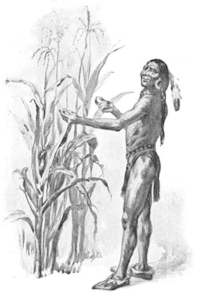
Early contacts between the Wampanoag and colonists date from the 16th century when European merchant vessels and fishing boats traveled along the coast of New England. Captain Thomas Hunt captured several Wampanoag in 1614 and sold them in Spain as slaves. A Patuxet named Tisquantum (or Squanto) was bought by Spanish monks who attempted to convert him before setting him free. He accompanied an expedition to Newfoundland as an interpreter, then made his way back to his homeland in 1619—only to discover that the entire Patuxet tribe had died in an epidemic.[19]
In 1620, the Pilgrims arrived in Plymouth, and Tisquantum and other Wampanoag taught them how to cultivate the varieties of corn, squash, and beans (the Three Sisters) that flourished in New England, as well as how to catch and process fish and collect seafood. They enabled the Pilgrims to survive their first winters, and Squanto lived with them and acted as a middleman between them and Massasoit, the Wampanoag sachem.
The Wampanoag suffered from an epidemic between 1616 and 1619, long thought to be smallpox introduced by contact with Europeans. However, researchers published a study in 2010 suggesting that the epidemic was leptospirosis, or 7-day fever.[20] The groups most devastated by the illness were those who had traded heavily with the French, leading to speculation that the disease was a virgin soil epidemic. Alfred Crosby has speculated that the population losses were as high as 90 percent among the Massachusett and mainland Pokanoket.[21]
Since the late 20th century, the event celebrated as the first Thanksgiving has been debated in the United States. Many American Indians argue against the romanticized story of the Wampanoag celebrating together with the colonists. Some say that there is no documentation of such an event, but there actually are two primary accounts of the 1621 event written by people who were present.[22]
Massasoit became gravely ill in the winter of 1623, but he was nursed back to health by the colonists. In 1632, the Narragansetts attacked Massasoit's village in Sowam, but the colonists helped the Wampanoag to drive them back.[19]
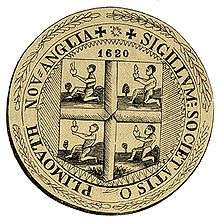
After 1630, the members of Plymouth Colony became outnumbered by the growing number of Puritans settling around Boston. The colonists expanded westward into the Connecticut River Valley. In 1637, they destroyed the powerful Pequot Confederation. In 1643, the Mohegans defeated the Narragansetts in a war with support from the colonists, and they became the dominant tribe in southern New England.[19]
Conversion to Christianity
After 1650, John Eliot and other Puritan missionaries sought to convert Indians to Christianity, and the converted Indians settled in 14 "praying towns." Eliot and his colleagues hoped that the Indians would adopt practices such as monogamous marriage, agriculture, and jurisprudence.[23] The high levels of epidemics among the Indians may have motivated some conversions. Salisbury suggests that the survivors suffered a type of spiritual crisis because their medical and religious leaders had been unable to prevent the epidemic losses.[24] By the latter half of the seventeenth century, alcoholism had become rampant among Indian men. Many turned for help to Christianity and Christian discipline systems. Christianity also became a refuge for women from drunkenness, with its insistence upon temperance and systems of retribution for drunkenness.
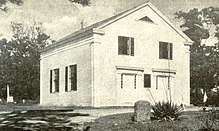
Individual towns and regions had differing expectations for Indian conversions. In most of Eliot's mainland "praying towns," religious converts were also expected to follow colonial laws and manners, and to adopt the material trappings of colonial life. Eliot and other ministers relied on praise and rewards for those who conformed, rather than punishing those who did not.[25] The Christian Indian settlements of Martha's Vineyard were noted for a great deal of sharing and mixing between Wampanoag and colonial ways of life. Wampanoag converts often continued their traditional practices in dress, hairstyle, and governance. The Martha's Vineyard converts were not required to attend church and they often maintained traditional cultural practices, such as mourning rituals.[26]
The Wampanoag women were more likely to convert to Christianity than the men. Experience Mayhew said that "it seems to be a Truth with respect to our Indians, so far as my knowledge of them extend, that there have been, and are a greater number of their Women appearing pious than of the men among them" in his text "Indian Converts".[27] The frequency of female conversion created a problem for missionaries, who wanted to establish patriarchal family and societal structures among them. Women had control of property, and inheritance and descent passed through their line, including hereditary leadership for men. Wampanoag women on Martha's Vineyard were the spiritual leaders of their households. In general, English ministers agreed that it was preferable for women to subvert the patriarchal model and assume a dominant spiritual role than it was for their husbands to remain unconverted. Experience Mayhew asked, "How can those Wives answer it unto God who do not Use their utmost Endeavors to Perswade and oblige their husbands to maintain Prayer in their families?"[28] In some cases, Wampanoag women converts accepted changed gender roles under colonial custom, while others practiced their traditional roles of shared power as Christians.
Metacomet (King Philip)
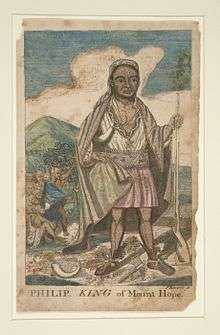
Massasoit was among those Indians who adopted colonial customs. He asked the legislators in Plymouth near the end of his life to give both of his sons English names. The older son Wamsutta was given the name Alexander, and his younger brother Metacom was named Philip. After his father's death, Alexander became the sachem of the Wampanoag. The colonists invited him to Plymouth to talk, but Wamsutta became seriously ill on the way home and died shortly after. The Wampanoag were told that he died of fever, but many Indians thought that he had been poisoned. The following year, his brother Philip (Metacom) became sachem of the Wampanoag.[29]
Under Philip's leadership, the relationship changed dramatically between the Wampanoag and the colonists. Philip believed that the ever-increasing colonists would eventually take over everything—not only land, but also their culture, their way of life, and their religion, and he decided to limit the further expansion of colonial settlements. The Wampanoag numbered only 1,000, and Philip began to visit other tribes to build alliances among those who also wanted to push out the colonists. At that time, the number of colonists in southern New England already numbered more than double that of the Indians—35,000 vs. 15,000. In 1671, Philip was called to Taunton, Massachusetts where he listened to the accusations of the colonists and signed an agreement that required the Wampanoag to give up their firearms. To be on the safe side, he did not take part in the subsequent dinner. His men never delivered their weapons.[29]
Philip gradually gained the Nipmuck, Pocomtuc, and Narragansett as allies, and the beginning of the uprising was first planned for the spring of 1676. In March 1675, however, John Sassamon was murdered.[30] Sassamon was a Christian Indian raised in Natick, one of the "praying towns." He was educated at Harvard College and had served as a scribe, interpreter, and counselor to Philip and the Wampanoag. But, a week before his death, Sassamon reported to Plymouth governor Josiah Winslow that Philip was planning a war against the colonists.
Sassamon was found dead under the ice of Assawompsett Pond a week later; three Wampanoag warriors were accused of his murder by a Christian Indian and taken captive by the colonists; they were hanged in June 1675 after a trial by a jury of 12 colonists and six Christian Indians. This execution was a catalyst for war, combined with rumors that the colonists wanted to capture Philip. Philip called a council of war on Mount Hope; most Wampanoag wanted to follow him, with the exception of the Nauset on Cape Cod and the small groups on the offshore islands. Allies included the Nipmuck, Pocomtuc, and some Pennacook and eastern Abenaki from farther north. The Narragansett remained neutral at the beginning of the war.[31]
King Philip's War
On June 20, 1675, some Wampanoags attacked colonists in Swansea, Massachusetts and laid siege to the town; they destroyed it completely five days later, leading ultimately to King Philip's War. The united tribes in southern New England attacked 52 of 90 colonial settlements, and partially burned them down.[29]
At the outbreak of the war, many Indians offered to fight with the colonists against King Philip and his allies, serving as warriors, scouts, advisers, and spies. Mistrust and hostility eventually caused the colonists to discontinue Indian assistance, even though they were invaluable in the war. The Massachusetts government moved many Christian Indians to Deer Island in Boston Harbor, in part to protect the "praying Indians" from vigilantes, but also as a precautionary measure to prevent rebellion and sedition from them.[32] Mary Rowlandson's The Sovereignty and Goodness of God is an account of her months of captivity by the Wampanoag during King Philip's War in which she expressed shock at the cruelties from Christian Indians.[33]
From Massachusetts, the war spread to other parts of New England. The Kennebec, Pigwacket (Pequawkets), and Arosaguntacook from Maine joined in the war against the colonists. The Narragansetts of Rhode Island gave up their neutrality after the colonists attacked one of their fortified villages. The Narragansetts lost more than 600 people and 20 sachems in the battle which became known as the "Great Swamp Massacre". Their leader Canonchet was able to flee and led a large group of Narragansett warriors west to join King Philip's warriors.[29]
The war turned against Philip in the spring of 1676, following a winter of hunger and deprivation. The colonial troops set out after him, and Canonchet was taken captive and executed by a firing squad. Canonchet's corpse was quartered, and his head was sent to Hartford, Connecticut to be put on public display.[29]
During the summer months, Philip escaped from his pursuers and went to a hideout on Mount Hope in Rhode Island. Colonial forces attacked in August, killing and capturing 173 Wampanoags. Philip barely escaped capture, but his wife and their nine-year-old son were captured and put on a ship at Plymouth; they were then sold as slaves in the West Indies. On August 12, 1676, colonial troops surrounded Philip's camp, and soon shot and killed him.
Consequences of the war
With the death of Philip and most of their leaders, the Wampanoags were nearly exterminated; only about 400 survived the war. The Narragansetts and Nipmucks suffered similar rates of losses, and many small tribes in southern New England were finished. In addition, many Wampanoag were sold into slavery. Male captives were generally sold to slave traders and transported to the West Indies, Bermuda, Virginia, or the Iberian Peninsula. The colonists used the women and children as slaves or indentured servants in New England, depending on the colony. Massachusetts resettled the remaining Wampanoags in Natick, Wamesit, Punkapoag, and Hassanamesit, four of the original 14 praying towns. These were the only ones to be resettled after the war.[34] Overall, approximately 5,000 Indians (40 percent of their population) and 2,500 colonists (5 percent) were killed in King Philip's War.[35]
18th to 20th century
Mashpee
The exception to relocation was the coastal islands' Wampanoag groups, who had stayed neutral through the war. The colonists forced the Wampanoag of the mainland to resettle with the Saconnet (Sekonnet), or with the Nauset into the praying towns in Barnstable County. Mashpee is the largest reservation set aside in Massachusetts, and is located on Cape Cod. In 1660, the colonists allotted the Indians about 50 square miles (130 km2) there, and beginning in 1665 they had self-government, adopting an English-style court of law and trials. The area was integrated into the district of Mashpee in 1763.
In 1788 after the American Revolutionary War, the state revoked the Wampanoag ability to self-govern, considering it a failure. It appointed a supervisory committee consisting of five European-American members, with no Wampanoag. In 1834, the state returned a certain degree of self-government to the First Nations People, and although the First Nations People were far from autonomous, they continued in this manner. To support assimilation, in 1842 the state violated the Nonintercourse Act when it illegally allocated plots from 2,000 acres (8.1 km2) of their communal 13,000 acres (53 km2), to be distributed in 60-acre (240,000 m2) parcels to each household for subsistence farming, although New England communities were adopting other types of economies. The state passed laws to try to control white encroachment on the reservation; some stole wood from its forests. A large region, once rich in wood, fish and game, it was considered highly desirable by the whites. With competition between whites and the Wampanoag, conflicts were more frequent than for more isolated Indian settlements elsewhere in the state.
Wampanoag on Martha's Vineyard
On Martha's Vineyard in the 18th and 19th centuries, there were three reservations—Chappaquiddick, Christiantown and Gay Head. The Chappaquiddick Reservation was part of a small island of the same name and was located on the eastern point of that island. As the result of the sale of land in 1789, the Indians lost valuable areas, and the remaining land was distributed among the Indian residents in 1810. In 1823 the laws were changed, in order to hinder those trying to get rid of the Indians and to implement a visible beginning of a civic organization. Around 1849, they owned 692 acres (2.80 km2) of infertile land, and many of the residents moved to nearby Edgartown, so that they could practice a trade and obtain some civil rights.[36]
Christiantown was originally a "praying town" on the northwest side of Martha's Vineyard, northwest of Tisbury. In 1849 the reservation still consisted of 390 acres (1.6 km2), of which all but 10 were distributed among the residents. The land, kept under community ownership, yielded very few crops and the tribe members left it to get paying jobs in the cities. Wampanoag oral history tells that Christiantown was wiped out in 1888 by a smallpox epidemic.[36]
The third reservation on Martha's Vineyard was constructed in 1711 by the New England Company (founded in 1649) to Christianize the Indians. They bought land for the Gay Head Indians who had lived there since before 1642. There was considerable dispute about how the land should be cultivated, as the colony had leased the better sections to the whites at low interest. The original goal of creating an undisturbed center for missionary work was quickly forgotten. The state finally created a reservation on a peninsula on the western point of Martha's Vineyard and named it Gay Head. This region was connected to the main island by an isthmus; it enabled the isolation desired by the Wampanoag. In 1849 they had 2,400 acres (9.7 km2) there, of which 500 acres were distributed among the tribe members. The rest was communal property. In contrast to the other reservation groups, the tribe had no guardian or headman. When they needed advice on legal questions, they asked the guardian of the Chappaquiddick Reservation, but other matters they handled themselves. The band used usufruct title, meaning that members had no legal claim to their land and allowed the tribal members free rein over their choice of land, as well as over cultivation and building, in order to make their ownership clear. They did not allow whites to settle on their land. They made strict laws regulating membership in the tribe. As a result, they were able to strengthen the groups' ties to each other, and they did not lose their tribal identity until long after other groups had lost theirs.[36]
The Wampanoag on Nantucket Island were almost completely destroyed by an unknown plague in 1763; the last Nantucket Wampanoag died in 1855.[36]
Current status
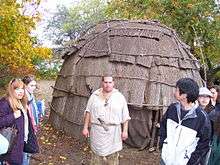
Slightly more than 2,000 Wampanoag are counted as enrolled members of the nation today (many have ancestry including other tribes and races), and many live near the reservation (Watuppa Wampanoag Reservation) on Martha's Vineyard, in Dukes County. It is located in the town of Aquinnah (formerly known as Gay Head), at the extreme western part of the island. It has a land area of 1.952 square kilometres (482 acres), and a 2000 census resident population of 91 persons.
Several bands of the Wampanoag have organized governments: Aquinnah of Gay Head, Assonet, Herring Pond, Mashpee, Pocasset, Pokonoket and Seekonk. Only the Aquinnah and Mashpee bands have gained federal recognition, although the other bands are recognized by the state of Massachusetts and have also applied for federal recognition as tribes.
Some genealogy experts testified that the tribes did not demonstrate the required continuity since historic times. For instance, in his testimony to the Bureau of Indian Affairs, the historian Francis Hutchins said that the Mashpee "were not an Indian tribe in the years 1666, 1680, 1763, 1790, 1834, 1870, and 1970, or at any time between 1666 and 1970 (Day 36, 130–140). In his opinion, an Indian tribe was "an entity composed of persons of American Indian descent, which entity possesses distinct political, legal, cultural attributes, which attributes have descended directly from aboriginal precursors." (Day 36, 124). Without accounting for cultural change, adaptation, and the effects of non-Indian society, Hutchins argued the Mashpee were not an Indian tribe historically because they adopted Christianity and non-Indian forms of dress and appearance, and chose to remain in Massachusetts as "second-class" citizens rather than emigrating westward (note: to Indian Territory) to "resume tribal existence." Hutchins also noted that they intermarried with non-Indians to create a "non-white," or "colored," community (Day 36, 130–140). Hutchins appeared to require unchanged culture, including maintenance of a traditional religion and essentially total social autonomy from non-Indian society."[37]
Wampanoag federally recognized tribes
Wampanoag Tribe of Gay Head (Aquinnah)
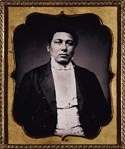
The Aquinnah ("land under the hill"[38][39]) Wampanoag Tribe of Gay Head, Massachusetts are the only Wampanoag tribe to have a formal land-in-trust reservation, which is located on Martha's Vineyard. Their reservation consists of 485 acres (1.96 km2) and is located on the outermost southwest part of the island. Aquinnah Wampanoag descendants formed the "Wampanoag Tribal Council of Gay Head, Inc." in 1972 for the purpose of self-determination and receiving federal recognition. Its members received government recognition in 1987 from the Bureau of Indian Affairs. The tribe has 1,121 registered members.[40]
Native Aquinnahers have a separate history; their myth has them arriving on an ice floe from the far North, and they sided with the white settlers in King Philip's War. They performed whaling from small boats,[41] and the character Tashtego from the Great American Novel Moby-Dick is a harpooner from Aquinnah.[42]
Gladys Widdiss, an Aquinnah Wampanoag tribal historian and potter, served as the President of the Wampanoag Tribe of Gay Head from 1978 to 1987.[43] The Aquinnah Wampanoag Tribe of Gay Head won federal recognition from the United States government during her tenure.[43] Under Widdis, the Aquinnah Wampanoag also acquired the Herring Creek, the Gay Head Cliffs, and the cranberry bogs surrounding Gay Head (now called Aquinnah) during her presidency.[43]
The Aquinnah Wampanoag are led by tribal council chair Cheryl Andrews-Maltais, who was elected to the post in November 2007.[44] In 2010, Andrews-Maltais put forward plans for the development of an Aquinnah reservation casino, which was met with opposition by state and local officials.[45] Current Chairperson is Tobias Vanderhoop.
Mashpee Wampanoag Tribe
The Mashpee Wampanoag Tribe consists of more than 1,400 enrolled members[46] who must meet defined membership requirements including lineage, community involvement and reside within 20 miles of Mashpee.[47] Since 1924 they have held an annual powwow at the beginning of July in Mashpee. The Mashpee Wampanoag Tribal Council was established in 1972 under the leadership of its first president, Russell "Fast Turtle" Peters. In 1974 the Council petitioned the Bureau of Indian Affairs for recognition. In 1976 the tribe sued the Town of Mashpee for the return of ancestral homelands. The case was lost but the tribe continued to pursue federal recognition for three decades.
In 2000 the Mashpee Wampanoag Council was headed by chairman Glenn Marshall. Marshall led the group until 2007 when it was disclosed that he had a prior conviction for rape, had lied about having a military record and was under investigation associated for improprieties associated with the tribe's casino lobbying efforts.[48] Marshall was succeeded by tribal council vice- chair Shawn Hendricks. He held the position until Marshall pleaded guilty in 2009 to federal charges of embezzling, wire fraud, mail fraud, tax evasion and election finance law violations. He steered tens of thousands of dollars in illegal campaign contributions to politicians through the tribe's hired lobbyist Jack Abramoff, who was convicted of numerous charges in a much larger scheme.[49][50] Following the arrests of Abramoff and Marshall, the newly recognized Mashpee Tribe led by new chair Shawn Hendricks, continued to work with Abramoff lobbyist colleague Kevin A. Ring pursuing their Indian gaming-related interests.[51] Ring was subsequently convicted on corruption charges linked to his work for the Mashpee band. Tribal elders who had sought access to the tribal council records detailing the council's involvement in this scandal via a complaint filed in Barnstable Municipal Court were shunned by the council and banned them from the tribe for seven years.[52]
In 2009 the tribe elected council member Cedric Cromwell to the position of council chair and president. Cromwell ran a campaign based on reforms and distancing himself from the previous chairmen, even though he had served as a councilor for the prior six years during which the Marshall and Abramoff scandals took place – including voting for the shunning of tribe members who tried to investigate.[53] A challenge to Cromwell's election by defeated candidates following allegations of tampering with voting and enrollment records was filed with the Tribal Court, and Cromwell's administration has been hampered by a series of protest by Elders over casino-related finances.[54][55]
The Mashpee Wampanoag tribal offices are located in Mashpee on Cape Cod. After decades of legal disputes, the Mashpee Wampanoag obtained provisional recognition as an Indian tribe from the Bureau of Indian Affairs in April 2006, and official Federal recognition in February 2007.[56] Tribal members own some land, as well as land held in common by Wampanoag descendants at both Chapaquddick and Christiantown. Descendants have also purchased land in Middleborough, Massachusetts upon which the tribe under Glenn A. Marshall's leadership had lobbied to build a casino. The tribe has moved its plans to Taunton, Massachusetts but their territorial rights have been challenged by the Pocasset Wampanoag.[57]
But Indian gaming operations are regulated by the National Indian Gaming Commission established by the Indian Gaming Regulatory Act. It contains a general prohibition against gaming on lands acquired into trust after October 17, 1988.[58] The tribe's attempts to gain approvals have been met with legal and government approval challenges.[59]
The Wampanoag Tribe's current plan has agreement for financing by the Malaysian Genting Group and has the political support of Massachusetts Senator John Kerry,[60] Massachusetts Governor Deval Patrick, and former Massachusetts Congressman Bill Delahunt, who is working as a lobbyist to represent the casino project.[61] Both Kerry[62] and Delahunt[63] received campaign contributions from the Wampanoag Tribe in transactions authorized by Glenn Marshall as part of the Abramoff lobbying scandal.
In November 2011, the Massachusetts legislature passed a law to license up to three sites for gaming resort casinos and one for a slot machine parlor.[64] The Wampanoag are given a "headstart" to develop plans for a casino in southeastern part of the state.[65]
Wampanoag state-recognized tribes
Herring Pond Wampanoag Tribe
The Herring Pond Wampanoag Tribe, headed by tribal council chair Melissa Ferretti, is state recognized. Historically one of the "praying towns" set up in the colonial era by The Commonwealth of Massachusetts, they are involved in the Wampanoag Language Reclamation Project.[66] In 1924 they helped organize the annual powwow at the beginning of July, which is now hosted in Mashpee. The first few pow wows in more than 200 years were held at the Herring Pond Wampanoag Meetinghouse before expanding and moving to Mashpee. The Mashpee Wampanoag and Herring Pond both petitioned at the same time to the Bureau of Indian Affairs for recognition.[67] They maintain offices in Buzzards Bay, Massachusetts. The Herring Pond Tribe claims as traditional lands a territory which ranges from the Plymouth (Plimouth Colony) areas to the upper parts of Cape Cod (Bourne, Sandwich and Plymouth).[68] In December 2018, ownership of a six-acre historical burial ground in Plymouth, Massachusetts was transferred to the Herring Pond Wampanoag Tribe.[69]
Assawompsett-Nemasket Band of Wampanoags
The Assawompsett-Nemasket Wampanoag territory is known today as Lakeville and Middleboro Massachusetts. The Assawompsett-Nemasket today have recognition within the commonwealth. They are the direct lineal descendants of Wattuspaquin the black Sachem of Assawompsett and Mionamie, Daughter of Supreme Sachem Ousameequin who greeted the first English settlers in continental North America. Throughout the 70s,80s and 90s the band was lead by Chief Misqui'pinoquet, Red Blanket, Clarence Wixon Jr. The tribe operated the Algonquian Indian Center in Brockton, Massachusetts. After Chief Red Blankets passing, his son Darrel Wixon or Pumaquoshim, Dancing Wolf was made chief and the current system of a hereditary band council was put back into place electing Jonathan Riley and Devin Wixon as council members to oversee the band. The Tribe hosts an annual Summer Social Powwow on its reservation in July.
Namasket (or Nemasket) Pokanoket Band
The Namasket (or Nemasket) Pokanoket Band was organized in 2000. It is one of the Pokanoket royal family clans of the Wattupa Reservation State Park in Freetown and Fall River, Massachusetts. Led by council chairman Chief George Spring Buffalo, it is clan members of the Pocasset State Recognized tribe. Tuspaquin and Anne [Black Sachem] was the Namasket Band of Royal family of the Pokanoket's resided in villages around the Taunton River near modern-day Middleborough, Massachusetts. It also included Squanto of the Patuxet tribe. Today's remaining Namasket lines are most related to the current-day Pocasset tribe of the Pokanoket Nation of Fall River.[70]
Pocasset Wampanoag Tribe (Pokonoket)
The Pocasset Wampanoag band has held lands in Fall River, Massachusetts since colonial times. They are the descendants and heirs of the Indians described in a deed from Benjamin Church dated November 1, 1709. Their government is organized under a traditional, clan-based system.[71] They manage a 201.2 acre reservation in Fall River[72] recognized under international law via the 1713 Treaty of Portsmouth[73] and the 1725 Treaty of Boston.[74] These treaties were entered into after Queen Anne's War, following raids such as those at Deerfield and Haverhill.
In 1869, the Commonwealth of Massachusetts passed the "enfranchisement act".[75] This act dissolved reservation status for lands held by the tribes, replacing it with fee-simple property allocated to individual Indians upon application of any member of that tribe to the judge of probate in the county that the lands were located.[76] The Pocassets resisted the enfranchisement act and previous attempts to divide the reserve into smaller parcels.[77] In the late 20th century, they resisted an attempt to have their lands put into federal trust,[78] managing to keep them intact.[79] The tribe has members living throughout Southeastern Massachusetts.[80] They applied for federal recognition in 1995 but were turned down.[81]
- Notable Pocassets
- Corbitant, sachem or sagamore of the Pocassets
- Weetamoo, his daughter and successor as the sachem of the Pocassets; one of her husbands was Wamsutta, a brother to King Phillip (Metacom)
- Woonekanuske, daughter of Corbitant, sister of Weetamoo, and wife of Metacom; she and her son were sold into slavery and transported to Bermuda following King Philip's War
- Leroy C. Perry, chief of the Wampanoags[82]
Also other Wampanoag groups
- Seaconke Wampanoag Tribe
- Royal House of the Pokanoket Tribe
- Chappaquiddick Wampanoag Tribe
- Cape Sable Island Wampanoag
Demographics
| Year | Number | Note | Source |
|---|---|---|---|
| 1610 | 6,600 | mainland 3,600; islands 3,000 | James Mooney |
| 1620 | 5,000 | mainland 2,000 (after the epidemics); islands 3,000 | unknown |
| 1677 | 400 | mainland (after King Philip's War) | general estimate |
| 2000 | 2,336 | Wampanoag | US Census |
| 2010 | 2,756 | Wampanoag | US Census |
Notable Wampanoag people
- Crispus Attucks, first man killed in Boston Massacre
- Joan Tavares Avant, author and historian
- Caleb Cheeshahteaumuck, the first American Indian to graduate from Harvard College
- Corbitant, 17th-century sachem of the Pocasset
- Sonny Dove, professional basketball player, New York City Basketball Hall of Fame
- Massasoit, the sachem who befriended the Mayflower pilgrims
- Metacom or Metacomet, Massasoit's second son, also called Philip, who initiated King Philip's War (1675–1676)
- John Sassamon, early translator
- Wamsutta, Massasoit's oldest son, also known as Alexander
- Weetamoo of the Pocasset, a woman who supported Metacom and drowned crossing the Taunton River during King Philip's War
- Gladys Widdiss tribal elder in Aquinnah reservation
Representation in other media
- Tashtego was a fictional Wampanoag harpooneer from Gay Head in Herman Melville's novel Moby Dick.
- Wampanoag history from 1621 to King Philip's War is depicted in the first part of We Shall Remain, a 2009 documentary.
See also
- Federally recognized tribes
- State recognized tribes in the United States
- The City of Columbus was a shipwreck where a group of Wampanoag risked their lives to save passengers
- Crispus Attucks
- Cuttyhunk
- Old Indian Meeting House, 1684 church
- List of early settlers of Rhode Island
Notes
- https://www.mass.gov/service-details/indian-affairs{{cite ="The Commonwealth of Massachusetts' Commission on Indian Affairs"
- Marr JS, Cathey JT. "New hypothesis for cause of an epidemic among Native Americans, New England, 1616–1619", Emerging Infectious Diseases, Centers for Disease Control, 2010 Feb doi:10.3201/edi1602.090276
- "Wampanoag." Dictionary.com Unabridged. Based on the Random House Dictionary, Random House, Inc. 2012. Retrieved 27 May 2012
- Bragdon, Kathleen J., "Native People of Southern New England, 1500-1650", University of Oklahoma Press, 1999, p. 21. ISBN 9780806131269
- Wright, Otis Olney, ed. (1917). History of Swansea, Massachusetts, 1667–1917. Town of Swansea. p. 18. OCLC 1018149266. Retrieved June 11, 2018.
- Plane, Anne Marie. Colonial Intimacies: Indian Marriage in Early New England. (Ithaca, NY: Cornell University Press), 2000: 20, 61.
- Handbook of North American Indians.
- See Bragdon, Kathleen, "Gender as a Social Category in Native Southern New England," Ethnohistory 43:4, 1996, p. 576, and Plane, Colonial Intimacies, p. 20.
- Plane, Colonial Intimacies, p. 20.
- Plane, Colonial Intimacies, p. 23.
- Salisbury, Neal. Introduction, Mary Rowlandson, The Sovereignty and Goodness of God. Boston, MA: Bedford Books, 1997, p. 11.
- (1978) "Indians of Southern New England and Long Island, early period," Handbook of North American Indians, vol. 15. (Bruce G. Trigger, ed.). Washington, D.C.: Smithsonian Institution, pp. 171f
- Williams, Roger. Narrangansett Women. (Originally published 1643, cited from Woloch, N., ed., Early American Women: A Documentary History, 1600–1900 (New York: McGraw-Hill), 1997, p. 8).
- Jeffrey Mifflin, "Saving a Language: A rare book in MIT's archives helps linguists revive a long-unused Native American language", Technology Review, May/June 2008, accessed November 18, 2011
- Salisbury, Neal and Colin G. Calloway, eds. Reinterpreting New England Indians and the Colonial Experience, Vol. 71 of Publications of the Colonial Society of Massachusetts. (Boston, MA: University of Virginia Press), 1993, pp. 278–79.
- Collins-Hughes, Laura (September 28, 2010). "'Genius grant' a boost to linguist as she revives a native language". Boston.com. Retrieved November 22, 2019.
- Fermino, Jessie Little Doe (Jessie Little Doe Christobal) (2000). An introduction to Wampanoag grammar (Master's thesis). Massachusetts Institute of Technology.
- "Jessie Little Doe Baird - MacArthur Foundation". www.macfound.org. Retrieved November 22, 2019.
- Die Welt der Indianer.
- Marr JS, Cathey JT (February 2010). "New hypothesis for cause of an epidemic among Native Americans, New England, 1616–1619". Emerging Infectious Diseases. 16 (2): 281–6. doi:10.3201/eid1602.090276. PMC 2957993. PMID 20113559. Archived from the original on 30 January 2010.
- Salisbury, Neal. Manitou and Providence, (Oxford University Press), 1982, p. 105.
- "Archived copy" (PDF). Archived from the original (PDF) on December 24, 2012. Retrieved October 9, 2014.CS1 maint: archived copy as title (link)
- Plane, Colonial Intimacies, pp. 47–48.
- Salisbury, Manitou and Providence, p. 106.
- Plane, Colonial Intimacies, p. 48.
- Ronda, James P. "Generations of Faith: The Christian Indians of Martha's Vineyard", William and Mary Quarterly 38, 1981, p. 378.
- Quoted from James Ronda, Generations of Faith, p. 384–88
- Experience Mayhew, sermon, "Family Religion Excited and Assisted," 1714–28, quoted from Plane, Colonial Intimacies, p. 114
- Wampanoag History
- For a much more detailed examination of John Sassamon, his murder, and its effects on King Philip's War, see Jill Lepore's The Name of War.
- Salisbury, Introduction to Mary Rowlandson, p. 21.
- Salisbury, Introduction to Mary Rowlandson, p. 23.
- See Mary Rowlandson, The Sovereignty and Goodness of God, pp. 75 and 98.
- Salisbury, Introduction to Mary Rowlandson, p. 37.
- Salisbury, Introduction to Mary Rowlandson, p. 1.
- Handbook of North American Indians. Chapter: Indians of Southern New England and Long Island, late period, pp. 178ff; Seaconke Wampanoag Tribe webpage; Mashpee Wampanoag Nation webpage; Wampanoag Tribe of Gay Head Aquinnah webpage
- "Testimony of Historian Francis Hutchins", Mashpee Wampanoag Final Determination, 2007.
- Boston Globe, May 15, 1997
- "Wampanoag" Archived October 29, 2013, at the Wayback Machine Cradleboard Teaching Project. Retrieved: 14 August 2012.
- Aquinnah Wampanoag tribal membership committee.
- "Aquinnah (previously knows as Gay Head)" Massachusetts Department of Housing and Community Development. Retrieved: 14 August 2012.
- Melville, H., "Moby-Dick", chapter 27. The Folio Society 2009. A Limited Edition with 281 illustrations by Rockwell Kent.
- Méras., Phyllis (June 15, 2012). "Gladys Widdiss Dies at 97, Was Widely Respected Tribal Elder". Vineyard Guardian. Retrieved July 2, 2012.
- Cheryl Andrews-Maltais elected Wampanoag chairman, Martha's Vineyard Times, November 21, 2007.
- "Aquinnah pitch island casino plan", Cape Cod Times, June 9, 2010.
- Final Determination for Federal Acknowledgment Report Archived September 21, 2012, at the Wayback Machine, Bureau for Indian Affairs, February 15, 2007.
- Mashpee Wampanoag Enrollment Ordinance, Bureau of Indian Affairs, filed 2007.
- "WampaGate – Glenn Marshall: There is still much to tell", Cape Cod Times, August 26, 2007.
- "Former Wampanoag leader sentenced", Boston Globe, May 8, 2009.
- "Marshall Timeline" Archived July 25, 2013, at the Wayback Machine, Cape Cod Times, August 25, 2007
- Cape tribe feels heat from lobbyist scandal Archived July 27, 2013, at the Wayback Machine, Cape Cod Times, September 11, 2008.
- Fed letter demands 8 pages of tribe's letters to Abramoff, others Archived November 4, 2008, at the Wayback Machine, Cape Cod Today, October 9, 2007.
- "Cedric Cromwell elected chairman" Archived September 29, 2011, at the Wayback Machine, Cape Cod Times, February 2, 2009.
- Mashpee Wampanoag elders gather outside tribal headquarters yesterday, seeking information about the tribe's finances since Chairman Cedric Cromwell took over, Cape Cod Times, September 24, 2009.
- Nellie Hicks Ramos v. Patricia Keliinui, 2009 Mashpee Wampanoag Tribe Election Committee Chair, Mashpee Wampanoag Tribal Court, January 17, 2012.
- "Mashpee Wampanoag win federal recognition". Boston Globe. February 15, 2007. Retrieved December 11, 2007.
- Pocasset Mashpee Wampanoags at odds over which tribe should get casino license for Taunton Archived January 22, 2013, at Archive.today, Enterprise Press, April 18, 2012.
- National Indian Gaming Commission, "Indian Land Options" Archived September 28, 2011, at the Wayback Machine
- "City ends deal to sell land for Mashpee Wampanoag Tribe casino" Archived October 7, 2011, at the Wayback Machine, Indian Gaming, January 19, 2011.
- WPRI News, "Sen. Kerry to support tribe land trust" Archived September 13, 2010, at the Wayback Machine, September 8, 2010.
- "Former Congressman Bill Delahunt to Represent the Mashpee Wampanoag Tribe" Archived March 17, 2011, at the Wayback Machine, Indian Country News, March 12, 2011.
- CampaignMoney.com, "Wampanoag federal campaign contributions" 2006.
- "Former MA Congressman to Lobby for Tribal Casino", Casino Suite News, March 11, 2011.
- Associated Press, "Massachusetts: Casino Bill Passes in Both Houses", New York Times, November 15, 2011
- Mark Arsenault, "Developers start to jockey for casino sites/Early groundwork laid in Springfield, Palmer" Archived November 20, 2011, at the Wayback Machine, Boston Globe,November 18, 2011
- Notice of Inventory Completion, Federal Register, 15 March 2011.
- US Census 2008 list of organizations Archived February 13, 2020, at Archive.today.
- Herring Pond Wampanoag Band official website.
- Clark, Emily (December 5, 2018). "Herring Pond Wampanoag burial ground comes home". Taunton Gazette. Retrieved November 29, 2019.
- The Nemasket/Plimoth Path, by Maurice Robbins, Massachusetts Archaeological Society.
- Pocasset Wampanoag Constitution
- Bk. 5, pp. 488–489, No. Dist.; Bk. 2, pp. 140–141, F. R. Cop. Rec. Deed of Benjamin Church
- http://kstrom.net/isk/maps/maritimes1693.html
- Treaty Black's Law Dictionary
- an act to enfranchise the Indians 1869
- MA House Files 1861 special report to the Governor and Council, of the Commonwealth, in the cases of Zurviah Gould Mitchell and John Hector.
- St. 1869, Ch. 463
- Pocasset Wampanoag v. City of Fall River, Massachusetts Appellate Tax Board, June 14, 2007.
- Petition for Federal Acknowledgment of Existence as an Indian Tribe, Federal Register, April 6, 1995.
- Speck, Frank G., 1928, "Territorial Subdivisions and boundaries of the Wampanoag, Massachusett and Nauset Indians" : 72. Indian notes and Monographs No.444, New York: Museum of the American Indian, Heye Foundation EXH. 99.
References
Online
- Wampanoag-Aquinnah Trust Land, Massachusetts United States Census Bureau
- Wôpanâak Language Reclamation Project
- Wampanoag Tribe of Gay Head Aquinnah webpage
- Cape Cod Times TRIBES RECONNECT: Part I, Worlds rejoined
- *Cape Cod Times TRIBES RECONNECT: Part II, 'We missed you'
- Pocasset Wampanoag Tribe of the Pokanoket Nation official website
- *Cape Cod Times Spade tooth discovery offers another clue to bloodline
- Cape Cod Times Finding a link that was never really lost
- Cape Cod Times Roots emerge in native dance
- Roots Web RECONNECTION FESTIVAL 2002
- The Royal Gazette Learning a valuable lesson
In print
Culture
- Bragdon, Kathleen. Gender as a Social Category in Native Southern New England. (American Society for Ethnohistory, Ethnohistory 43:4). 1996.
- Moondancer and Strong Woman. A Cultural History of the Native Peoples of Southern New England: Voices from Past and Present. (Boulder, CO: Bauu Press), 2007.
- Plane, Anne Marie. Colonial Intimacies: Indian Marriage in Early New England. (Ithaca, NY: Cornell University Press), 2000.
- Salisbury, Neal. Introduction to The Sovereignty and Goodness of God by Mary Rowlandson. (Boston, MA: Bedford Books), 1997.
- Salisbury, Neal and Colin G. Calloway, eds. Reinterpreting New England Indians and the Colonial Experience. Vol. 71 of Publications of the Colonial Society of Massachusetts. (Boston, MA: University of Virginia Press), 1993.
- Waters, Kate, and Kendall, Russ. Tapenum's Day – A Wampanoag Indian Boy in Pilgrim Times. (New York, Scholastic), 1996. ISBN 0-590-20237-5
- Williams, Roger. "Narrangansett Women." (1643).
History
- Lepore, Jill. The Name of War. (New York: Alfred A. Knopf), 1998.
- Rowlandson, Mary. The Sovereignty and Goodness of God. (Boston, MA: Bedford Books), 1997.
- Salisbury, Neal. Introduction ∑to The Sovereignty and Goodness of God by Mary Rowlandson. (Boston, MA: Bedford Books), 1997.
- Salisbury, Neal. Manitou and Providence. (Oxford: Oxford University Press), 1982.
- Silverman, David. Faith and Boundaries: Colonists, Christianity, and Community Among the Wampanoag Indians of Martha's Vineyard, 1600–1871. (New York: Cambridge University Press), 2007. ISBN 0-521-70695-5.
- Leach, Douglas Edward. Flintlock and Tomahawk. (Norton: The Norton Library ISBN 978-0-393-00340-6), 1958.
Conversion and Christianity:
- Mayhew, Experience. "Family Religion Excited and Assisted." (1714–1728).
- Mayhew, Experience. "Indian Converts." (1727). (U. Mass. P. edition ISBN 1-55849-661-0), 2008. Indian Converts Collection
- Ronda, James P. Generations of Faith: The Christian Indians of Martha's Vineyard. (William and Mary Quarterly 38), 1981.
- Salisbury, Neal. Manitou and Providence. (Oxford: Oxford University Press), 1982.
External links
| Wikimedia Commons has media related to Wampanoag. |
Federally recognized
State recognized Colonial Era Tribe
Other
- Plimoth Plantation – living history